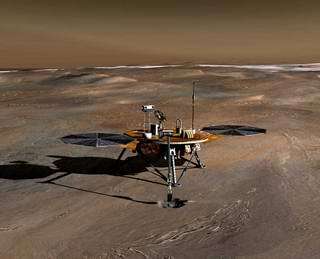NASA's Phoenix Mars lander flexed its robotic arm Thursday in a successful test of the key element in the probe's mission to investigate the Red Planet's soil for conditions conducive to life, NASA said.
"The arm is ready to go" said Matt Robinson of the US space agency's Jet Propulsion Laboratory in Pasadena, California, where the Phoenix mission is managed.
"Yesterday we sent commands ... down to the lander to unstow the arm, and today I am ecstatic to let you know that it was successful.
"The robotic arm is now unstowed, it's out of its launch restraints."
The 2.35 meter- (7.7 foot-) titanium and aluminum backhoe-like extension, with a scoop on the end to dig into the Martian arctic permafrost-like soil, unlatched its arm-locks by command from the JPL, lifted its forearm and then freed its elbow restraint.
"We have achieved a major milestone for the mission," said Barry Goldstein, Phoenix project manager at the JPL.
The next step is to test the arm's four joints to be sure it is in working order before beginning to dig into the soil.
With its hard scoop on the end, the arm can dig a half-meter (20 inches) into Martian soil, where scientists hope to prove the existence of water in its liquid form and organic minerals, both of which need to be present for the existence of microbial life.
(c)AFP 2008
























